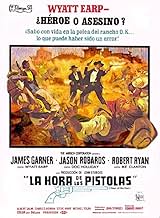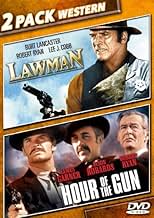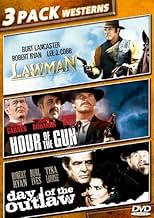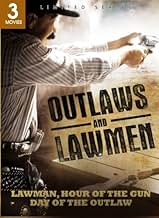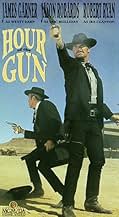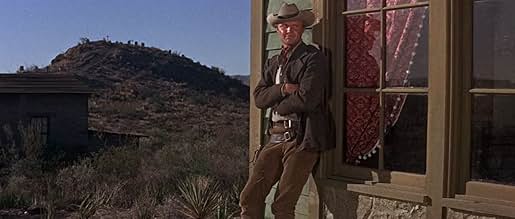Adicionar um enredo no seu idiomaMarshal Wyatt Earp kills a couple of men of the Clanton gang in a fight. In revenge, Clanton's thugs kill the Marshal's brother. Thus, Wyatt starts to chase the killers together with his fri... Ler tudoMarshal Wyatt Earp kills a couple of men of the Clanton gang in a fight. In revenge, Clanton's thugs kill the Marshal's brother. Thus, Wyatt starts to chase the killers together with his friend Doc Holliday.Marshal Wyatt Earp kills a couple of men of the Clanton gang in a fight. In revenge, Clanton's thugs kill the Marshal's brother. Thus, Wyatt starts to chase the killers together with his friend Doc Holliday.
Avaliações em destaque
This traditional western deals what happens later the gun-play at Tombstone . It's a sequel from superior version and more famous actors (Douglas and Lancaster) by the same director ¨Gunfight at the OK Corral¨(1957) . Prior to production , United Artists had made it quite clear to director John Sturges that none of the primary roles were to be filled by the actors who played the same characters in Sturges' previous Wyatt Earp film . Wanting to distinguish this film from the previous one , they demanded different actors be cast in the roles . The main character is a historical figure , in this case the sheriff Wyatt Earp who participated the most known duel occurred in the western town of Tombstone in 1881 that has been brought to the big screen many times as in the classic "My Darling Clementine" in 1946 directed by John Ford with Henry Fonda and Victor Mature , the famous "Gunfight at O.K. Corral" (1957) by specialist John Sturges who would resume the same story in this "The Hour of the Gun" (1967) ; the demystifying "Doc" (Frank Perry, 1971) with Harris Yulin and Stacy Keach or the more modern "Tombstone: The Legend of Wyatt Earp" (George P. Cosmatos, 1993) with Kurt Russell and Val Kilmer and ¨Wyatt Earp¨ (Lawrence Kasdan, 1994) with Kevin Costner and Dennis Quaid . ¨Hour of guns¨ packs an enjoyable and glimmer cinematography by Lucien Ballard . This thrilling film contains a spectacular and atmospheric musical score by the great Jerry Goldsmith . The motion picture was professionally directed by John Sturges.
The picture was based correctly on real events , thus : In 1879 Wyatt and his brothers and Doc Holliday arrived in Tombstone . Virgil became the town marshal . Trouble brewed up among the Earp gang and Clanton-McLaury faction which resulted the explosive showdown that lasted thirty seconds and Virgil and Morgan were badly wounded . Less than a year after the incident , Morgan was killed in an ambush . In response Wyatt and Holliday tracked down and shot the two man they considered to be Morgan's killers, and were forced to elude a pursuing posse in Colorado . Far from fitting the popular description of a stand-off among good guys and bad guys some historians consider the incident OK corral to be nothing but cold blooded murder of the Clanton and McLaurys some of whom were unarmed,by the Earps and Doc . The Earps always maintained the show down was fought in self-defense . Wyatt Earp lived on until 1929 but will always be remembered as the hero of OK Corral , however Doc , an alcoholic dentist turned gambler and gunman, will die soonest .
Robert Ryan is a superior actor, but Clanton wasn't a land baron. Clanton was a rustler/rancher, loud-mouth/coward that provoked the gunfight at the O.K.corral and lost the case for the prosecution by being a not-too-bright liar. I don't know if Ryan could be cast correctly to portray the real Ike Clanton.But he does well regardless. Earp also didn't really kill Ike.
This movie does explore the vigilante ride of Wyatt and Doc after the wounding of Virgil and the killing of Morgan Earp. Pete Spence was never a sheriff, and Sherm McMasters was a cowboy that informed for Wyatt. The movie is a superior western and as close to accurate as Hollywood came until "Tombstone" and "Wyatt Earp".
The mood is somewhat interesting but it wasn't a moral struggle for Wyatt and Doc in real life. They were doing what they felt was right, vengeance. Earp thought in very black and white terms, killing his brothers killers was the right thing to do in his mind. It didn't matter if it was against the law he often swore to protect as a peace officer in those western boom towns. He was always upright and correct in his profession as a lawman, but in matters of family he was not on the job and no longer wearing a badge. his duty to law enforcement no longer applied.
The cast are good despite not having anyone carried over from the first film. Garner does make for a mean Wyatt and even if the material doesn't go deep, Garner's eyes show that he understands what he is doing. Robards is enjoyable as Holliday and has one of the film's best dialogue scenes when he confronts the man he once looked up to. Ryan isn't as key as I had hoped and the narrative keeps him to the side for the majority of the film. The support cast are mainly good enough for the genre but it is Garner and Robards who dominate the whole thing.
Overall this is a solid and enjoyable period western. The dark revenge and hatred within Wyatt is hinted at but it is only really Garner who seems to want to really bring it out of his character as the film only toys with it while staying in firmly old-fashioned territory. Could have been a lot more interesting then but still manages to be an enjoyable western for fans of the genre as it was before changing in the late sixties.
Sturges believed there were three essentials to every Western: 1. Isolation a man standing alone with no hope of help from outside (e.g. Spencer Tracy's predicament in "Bad Day at Black Rock when the telegraph lines are cut). 2. A man, or group of men compulsively take law and justice, rightly or wrongly, into their own hands (e.g. "The Magnificent Seven"). 3. The issues are resolved by violence in the form of gunplay (e.g. "Gunfight at the OK Corral," "Hour of the Gun"). He followed this up by saying: 'A Western is a controlled, disciplined, formal kind of entertainment. There's good and bad; clearly defined issues; there's chase; there's a gunfight.'
"Hour of the Gun" covers the period just after the famous gun battle The film is well done but there are some downfalls: It shows only one face of Wyatt his "official" law abiding side, with no women in his life And also no Johnny Ringothe main bad guy and rival of Doc Holliday
There are solid performances all around, beginning with James Garner who plays a hero with a badge, and is powerful in his intensity Wyatt's vengeance for the murder of his brother show the primal potency of violence
Robards plays John Hollidayan ordinary man dying of tuberculosis who becomes one of Wyatt's most loyal allies with an insatiable greed for drinking, gambling and fighting Robards is quite good in his character, and does deliver a couple of colorful lines to Earp The relationship and chemistry between the two men is unique It's difficult to outline, but it's like these two were old souls who would go through hell with/for each other and never need to wonder or to argue it
Ryan, as a Westerner, has played straight as well as crooked his hunted killer in "The Naked Spur" and his ageing lawman (losing his vision at crucial moments) in "The Proud Ones" being equally memorable In more recent roles he has been basically sympathetic as the horse-handler in "The Professionals," as William Holden's weary, reluctant pursuer in "The Wild Bunch," as the pacifist sheriff in "Lawman" the exception being "Hour of the Gun," in which once again he was the outlaw on the run, this time with a relentless Wyatt Earp in pursuit Ryan has perhaps achieved more as an actor in other genres, but the Western would have been the poorer without him
Although John Sturges' Gunfight at the O.K. Corall ten years previously proved to be popular, the director was never happy with the finished project, due in no small part to the fact that Hal B. Wallis controlled the script. Here Sturges takes control and crafts what in essence is a sequel to the 57 movie. Leaning more towards a character study with a dark edge, Hour of the Gun is refreshing in giving the Wyatt Earp/Doc Holliday characters a different story than the one we normally see on the screen; one that actually attempts historical accuracy where possible.
Viewing it now it's easy to see why the film was received coldly back on release. The Western movie was just about creaking along as a viable cinematic genre as it was, but with Sturges and Anhalt portraying one of America's folklore heroes in moral decline, it's unsurprising that it found itself out of sync with the times. However, time has been very kind to it, where over decades the re-evaluation of many a psychological Western has seen it viewed as one of the more bolder and cynical tinted oaters from the 60s.
With a fine script from Anhalt to work from, who also features as a player in the film as Holliday's whiskey smuggling carer, the cast work well. Ryan files in for villain duties as Ike Clanton and Garner as Earp and Robards as Holliday make for a suitably sombre pairing. There's also some quality in the support ranks where Albert Salmi, John Voight, Jorge Russeck and Karl Swenson leave good impressions. With Goldsmith tonally aware for the scoring and master photographer Ballard utilising the Panavision on offer for the Durango locations, it's an all round well put together production.
Some fat could have done with being trimmed off it to get it 10 minutes shorter; for the story starts to feel over long entering the last quarter. But Hour of the Gun is not only a better than your average 60s Western, it's also one of the better Wyatt Earp movies available to those interested in the subject. 7.5/10
Você sabia?
- CuriosidadesPrior to production, United Artists had made it clear to director John Sturges that none of the primary roles were to be filled by actors who had played the same characters in Sem Lei e Sem Alma (1957). Sturges believed that the roles of Virgil and Morgan Earp from the previous film were small enough that the same actors could do it again without harming the film's uniqueness. The studio agreed, and allowed Sturges to cast John Hudson and DeForest Kelley. Hudson had retired from acting in the early 1960s, and was unwilling to come back. Kelley was working on Jornada nas Estrelas (1966) and unable to break away. Thus, both Earp brothers were re-cast.
- Erros de gravaçãoIn the gunfight, it shows only Billy Clanton, Tom McLaury and Frank McLaury in the OK Corral and the Earps outside. In reality, the gunfight took place in a vacant lot behind the OK Corral. In that lot were the Earp party, Billy Clanton, the McLaury's, Ike Clanton and Billy Claibourne along with two horses.
- Citações
Dr. Charles Goodfellow: I can't understand why I never win.
Dr. John 'Doc' Holliday: You don't play very well. Besides that, you never cheat.
- Cenas durante ou pós-créditosOpening credits prologue: THIS PICTURE IS BASED ON FACT. THIS IS THE WAY IT HAPPENED.
TOMBSTONE, TERRITORY OF ARIZONA OCTOBER 26, 1881
- ConexõesReferenced in Jornada nas Estrelas: Spectre of the Gun (1968)
Principais escolhas
- How long is Hour of the Gun?Fornecido pela Alexa
Detalhes
- Data de lançamento
- País de origem
- Idiomas
- Também conhecido como
- La hora de la pistola
- Locações de filme
- Empresas de produção
- Consulte mais créditos da empresa na IMDbPro
Bilheteria
- Orçamento
- US$ 1.800.000 (estimativa)
- Tempo de duração
- 1 h 40 min(100 min)
- Cor
- Proporção
- 2.35 : 1


